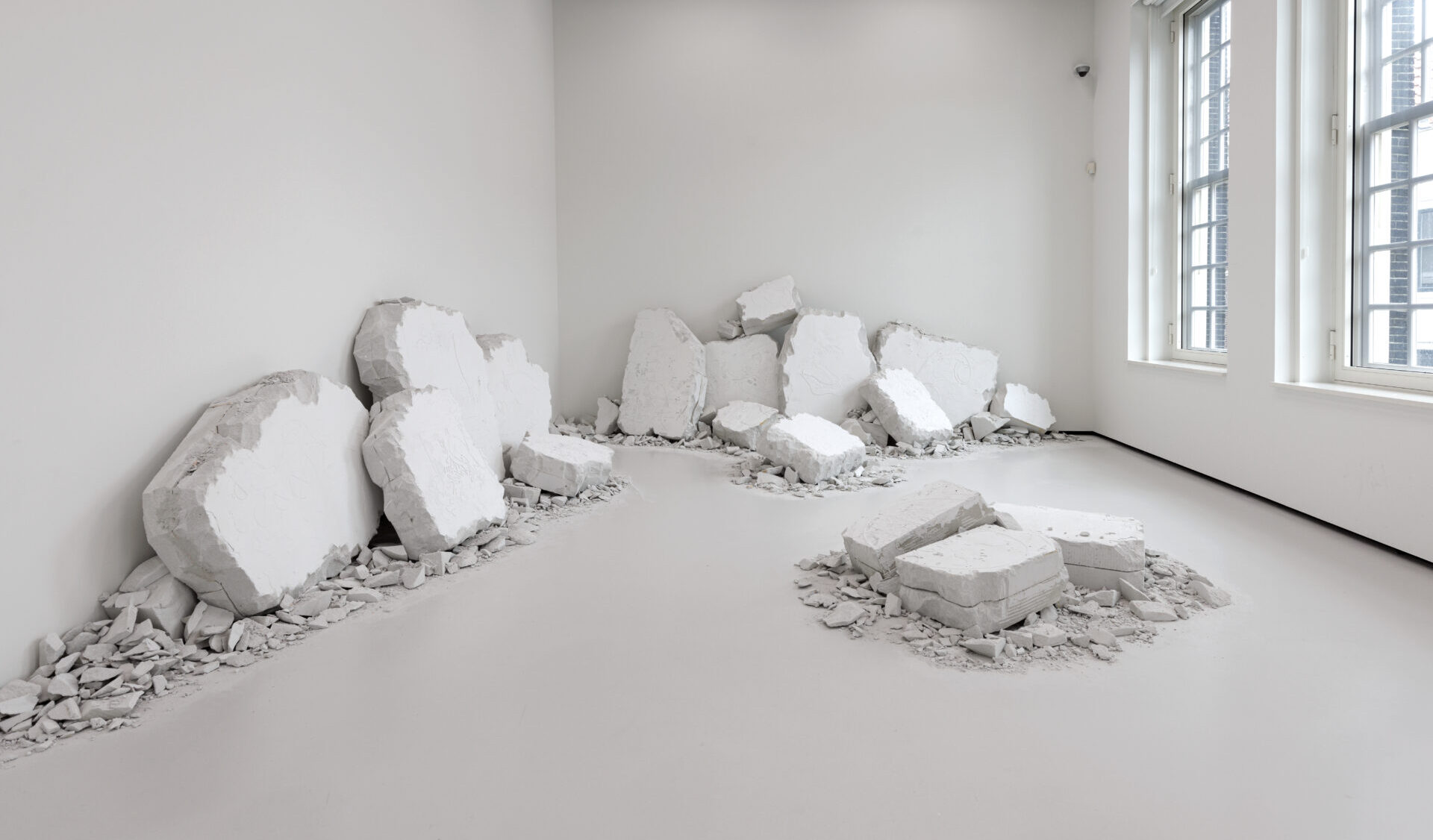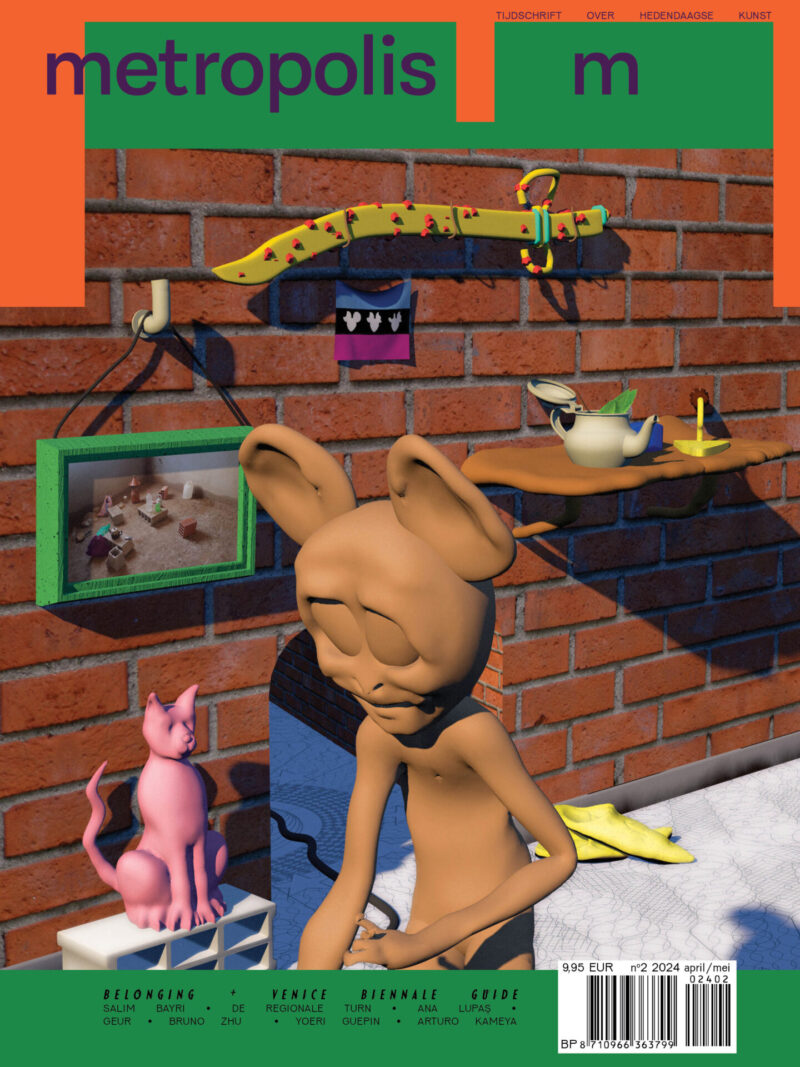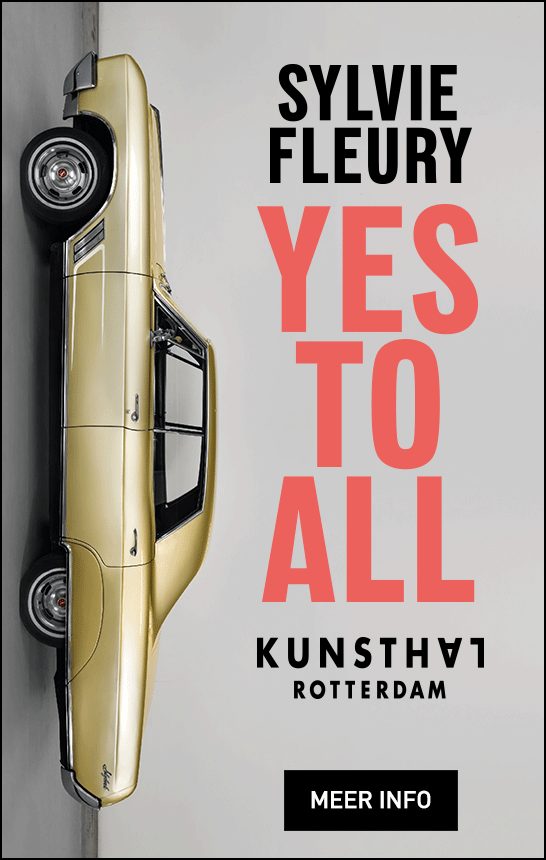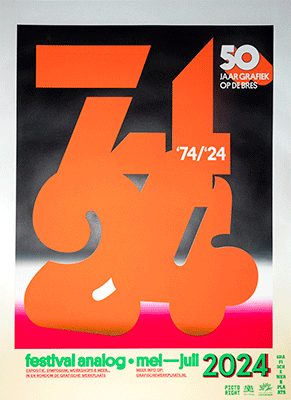
A Memoirs of Messages – The Volkskrant Beeldende Kunst Prijs at Stedelijk Museum Schiedam
This year’s nominations for de Volkskrant Beeldende Kunst Prijs (Visual Arts Prize) include Victor Crepsley, Sebastian Haquin, Narges Mohammadi, Josse Pyl, and Dion Rosina. Their work is currently on view at the Stedelijk Museum Schiedam. Karmen Samson visits the exhibition and picks her favourite.
Buckets, shovels, foam balls, water shoes, and even an inflatable boat are scattered on the floor of the Stedelijk Museum Schiedam, evoking memories of seaside adventures. What makes the scene atypical is that these beach toys and essentials are all bathed in pristine white. Despite their seemingly innocent appearance, these objects evoke an eerie sensation I cannot quite pinpoint. What hidden messages might lie within this unexpected display?
This setting offers an intriguing welcome to the de Volkskrant Beeldende Kunst Prijs (Visual Arts Prize) exhibition, a platform dedicated to showcasing emerging talent under the age of 35 in the Netherlands. De Volkskrant has enlisted experts from the art scene to select five artists for this prestigious competition.[1] This year’s nominations include Victor Crepsley, Sebastian Haquin, Narges Mohammadi, Josse Pyl, and Dion Rosina.
This 15th edition is held on the museums first floor, occupying two modest yet purposeful rooms. Upon crossing the threshold into the first room, I am welcomed by an aura of tranquil serenity, akin to the classical white cube museum setting. However, this illusion of calm belies the impending sensory explosion of colour, material and messaging that awaits me just a quarter turn away. The overwhelming sensation, particularly accentuated in the realm of reflections and references, is equally prevalent in the more subdued works of Mohammadi, Pyl, and Rosina as it is in the vibrant creations of Crepsley and Haquin. Despite their disparate aesthetics, these works are bound by a common engagement with the complexities of contemporary existence, fused with personal memories that lie in the interpretation of visual and textual messaging.
Despite their disparate aesthetics, these works are bound by a common engagement with the complexities of contemporary existence, fused with personal memories that lie in the interpretation of visual and textual messaging

The first room is cleverly divided by a strategically placed wall at its center. While the works are showcased together, they do indeed benefit from having some more subdued spaces allocated to them. On the left side of the division, I am encountered by the work of Narges Mohammadi (1993). The Kite That Never Flew (2023) is deeply personal work, for which Mohammadi drawn from her own life journey of fleeing Afghanistan with her family and seeking asylum in the Netherlands. The work is anchored in a newspaper article titled New Phenomenon on the French Coast: Boats Pick Up Migrants from Tourist Beaches and is exhibited alongside her other pieces.[2] Instead of having the article being printed on glossy paper or framed, it is simply a copy print of a digital article taped to the museum wall. Its placement seems almost arbitrary, prompting a moment of doubt about its deliberate presentation. However, this mode of presentation serves as a poignant reflection of how contemporary Western society grapples with information overload and simulation, rendering us desensitized to even the most alarming realities. For many, the news article serves as a representation, while for others, it’s a harsh reality. Mohammadi’s mummified toys, their forms remaining intact, but their purpose blurred, serve as stark symbols of stolen innocence, encapsulating a faint trace of what should have been a joyful childhood. The presence of the news article offers crucial context, revealing that the solid white paste not only hides the neon-colored plastic but, more importantly, veils a reflection of a grim reality.
On the other side of the wall, a different set of childhood memories awaits exploration, this time from the perspective of Viktor Crepsley (1996). Drawing from his recollections of traveling to Singapore, New York, Dubai, and Las Vegas during his youth, Crepsley infuses elements of contemporary consumption and media culture into his creations. Through his vibrant and often tactile works, the interdisciplinary artist skillfully blurs the boundary between fiction and reality, inviting viewers into a dynamic exploration of memory and perception. Take for example his piece Colossus (2023), which embodies this ethos: a broken Mercedes-Benz car lamp, which Crepsley saw as resembling a dragon’s eye, repurposed into a sculptural work. He humorously suggests: ‘If you can’t afford a car, just buy this piece and have a Ferrari monster in your living room’, also offering a playful twist on the concept of a ‘race monster.’
My mind was abuzz with thoughts after encountering these works, rendering me momentarily indecisive about whom to vote for


Dion Rosina’s (1991) work also distorts reality, encompassing paintings and mystical collages that draw from historical footage, mythology, and personal imagination. Rosina uses mainly existing images, subjecting them to extensive reworkings and alterations. While his presentations may incorporate inexplicable phenomena, Rosina’s subject matter is undeniably real, revolving around the often-overlooked history of the African diaspora and its contemporary relevance. Through his urgent work, Rosina prompts viewers to contemplate multiple layers and alternative perspectives.
Sebastian Haquin’s work (1991) engages in a similar manner in crafting alternative perspectives, albeit from a rather different vantage point. Rooted in dreams and distorted memories, Haquin intricately weaves elements of allegorical scenes with real people or places, immortalizing them within his paintings. In his own words, his process is ’taking the idea in your head and marrying it to some kind of real-world imagery’. Consequently, he prompts viewers to question whether they are merely gazing upon an illusion or if there is more to uncover.
Entering the second room, I am immediately struck by the dominance of Josse Pyl’s (1991) work. Its grand scale and impressive arrangement command attention, with scattered concrete debris imbuing the space with a sense of faded grandeur, hinting at a bygone allure. Central in Pyl’s work is the usage of text by means of reinterpretations of signs and symbols. For Pyl, language is not merely a black and white phenomenon confined to paper; rather, it is an emotional and physical experience. For his work can tt ast emy th oug ths (2023), he extracted communication patterns from figures, icons, and symbols, and transformed these elements of language into material forms, such as concrete. While Pyl’s work offers a palpable encounter with the elusive nature of language, the extent to which symbols provide new meanings through this material transformation remains unclear. The exact message may, potentially, have gotten lost in translation.
As the title of the exhibition suggests, there are prizes to be won. In fact, there are two: the jury prize of €10.000 and the audience prize of €2.500, which will be unveiled on Sunday June 9, during a special public day event. Visitors have until then to cast their votes in a ballot box located within the exhibition.
My mind was abuzz with thoughts after encountering these works, rendering me momentarily indecisive about whom to vote for. Yet, amidst the whirlwind of memories and reflections, a quite narrative spoke volumes. Whilst thinking of the tiny pair of water shoes, laying abandoned in the corner of a vast white space, I wrote Narges Mohammadi on the ballot. Hoping for a future reality where those toys break free from their solidified white encasement, and once again gleam in their original striking blue, yellow, and pink tones. Imagining them joyously played with by a carefree child, setting off for a sunny afternoon on the beach.
[1] The panel for this year includes fashion designer Duran Lantink, artist and curator Charl Landvreugd, curator Inez Piso, artist Constant Dullaart, and art collective/gallery Opperclaes, represented by Linda van der Vleuten and Bruce Tsai.
[2] Nieuw fenomeen aan Franse kust: bootjes pikken migranten op van toeristische stranden. (2022, July 23). www.ad.nl. Retrieved April 11, 2024, from https://www.ad.nl/buitenland/nieuw-fenomeen-aan-franse-kust-bootjes-pikken-migranten-op-van-toeristische-stranden~af0e512d/?referrer=https%3A%2F%2Fwww.google.com%2F.
Karmen Samson
is modebeoefenaar en onderzoeker met interesses in materiële cultuur en museologie























